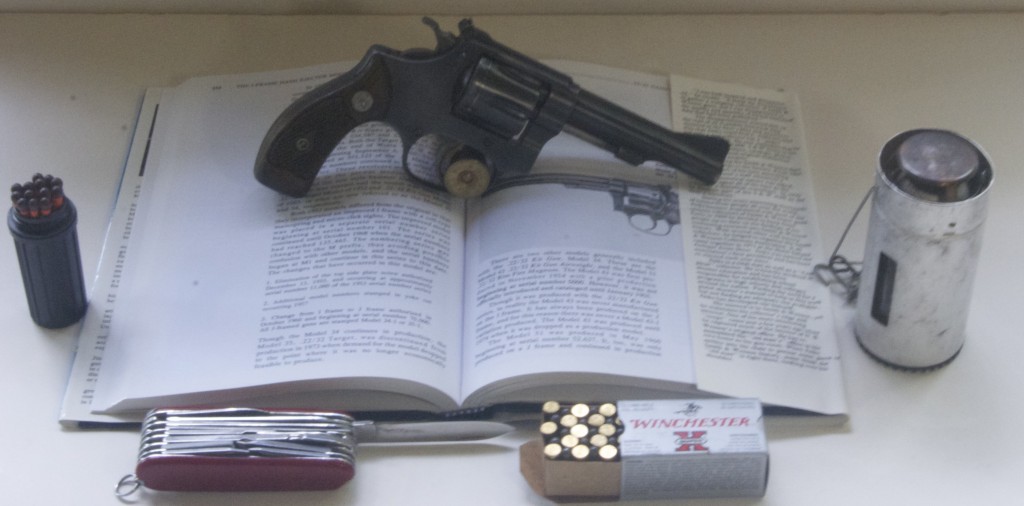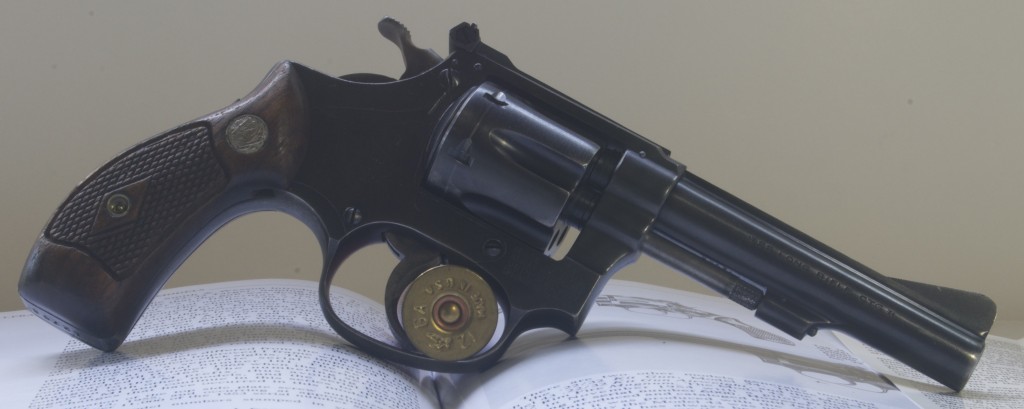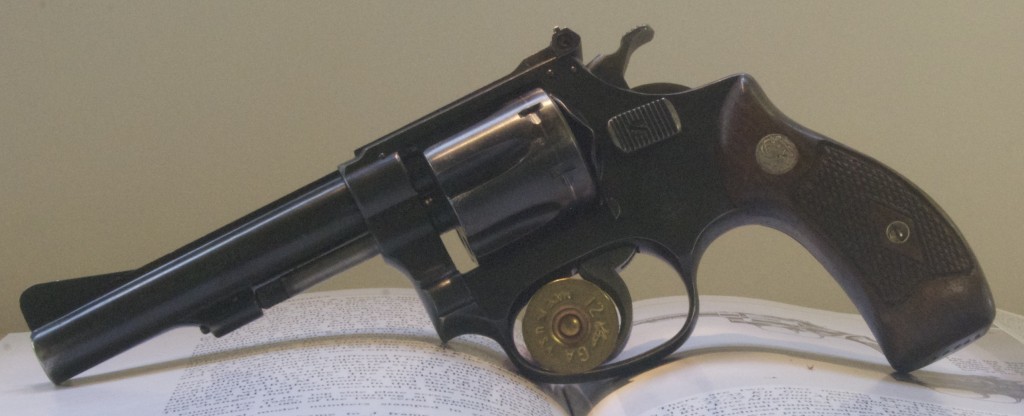Before last week, I had not purchased a gun since July of 2012*.
There are reasons for that. One was that I went through a period of unemployment, where I wasn’t purchasing anything but essential items.
A second reason is that it has been hard to find things I’ve been interested in purchasing. My local gun shops have had very few used guns that I was interested in; it seems that people are mostly holding on to guns rather than trading them in. When Mike the Musicologist and I went down to San Antonio, I did find a few interesting used guns, but either the prices were out of line (in my opinion) or (at Nagel‘s) I didn’t have the ready cash available to make the purchase.
When I decided I was going to the Smith and Wesson Collectors Association symposium in Columbus, I thought there was a good chance that I’d break the drought. I don’t buy guns just for the sake of buying guns, but I generally have a mental list of “grail” guns at any given time. The S&WCA annual meetings are a good place to find at least some of those guns, since many of my “grail” guns are Smiths.
I was lucky enough to find two guns that I fell in love with, both at the table of noted dealer David Carroll. I was even luckier in that they were within price ranges I felt I could afford, and that Mr. Carroll was willing to work with me on payment and shipping. (Mr. Carroll is a swell guy. Go buy things from him. Please.)
(As a side note, it isn’t as easy to buy guns over the Internet or out of state as lying liars who lie would have you believe. The S&WCA meeting was in Ohio. I live in Texas. As a non-resident of Ohio who doesn’t have any type of Federal Firearms License (FFL), I couldn’t legally buy a gun in the state. Private sale or dealer, it wouldn’t make any difference; I’d be breaking the law, as would the person who sold it to me. I had to have my dealer in Texas send Mr. Carroll (who is a licensed dealer) a copy of his FFL, Mr. Carroll had to ship the guns to my FFL dealer, and then I had to go to my dealer, fill out a BATFE Form 4473, and provide my Texas concealed carry permit to my FFL dealer before I could take possession of the guns. If I didn’t have a Texas concealed carry permit, I still could have gone through with the purchase, but my dealer would have had to phone in a NICS check. The only thing my Texas concealed carry permit gets me is bypassing the phone call, since I’ve already been through a background check.)
(If I had a limited collectors license, what BATFE calls a “Curios and Relics” (or “C&R”) license, I probably could have brought one of the guns home with me. The “C&R” license is less expensive and less invasive than a full FFL, but it limits you (generally) to guns more than 50 years old. So I still would have had to have the second gun shipped to my FFL, plus there’s the whole “traveling with a gun on an airline” thing, which is kind of complicated.)
(And I’ll admit, it gave me more than a little thrill when I went to my FFL to pick up the guns, and the guy behind the counter said, “Oh, yeah. I saw those earlier. Those are pretty.” They especially admired the one I’m about to write about.)
(I’m sure many of my readers already know these things. The above is for the benefit of new readers, and people who may not be aware of the process. Remember: lying liars who lie, will lie.)
After the jump, photos and words and things.
Back around 1910, a gun dealer in San Francisco named Philip Bekeart approached Smith and Wesson with an idea. At the time, S&W was building revolvers chambered in the .32 S&W Long caliber on a small frame. Mr. Bekeart’s idea was to build a target gun chambered in .22 caliber on the same frame used for the .32 revolvers. Even better, he told S&W that he’d order 1,000 of these revolvers.
S&W, at the time, was willing to build pretty much anything within reason if you had the money and/or would commit to ordering a certain number of guns. (That’s pretty much the way things are today, as well. Google “Lew Horton Smith Wesson revolvers” for examples.) Mr. Bekeart only got 292 out of those 1,000 revolvers, but S&W still liked the idea. The Bekeart revolvers evolved into the “.22/32 Heavy-Frame Target” (because they were .22 caliber revolvers built on a .32 caliber frame, with adjustable sights and a 6″ barrel). In 1936, Smith and Wesson came out with a new variant, which had a 4″ barrel along with adjustable sights. This became known as the “.22/32 Kit Gun”.
They called it a “Kit Gun” because the idea was you could slip it into your fishing kit. Or your hunting kit. Or your camping kit. It was something small and compact that you could take with you and perhaps use to get some small game for the pot (if the fishing was bad). It was a time when gentlemen were known to carry a vest pocket pistol, like a .32 Colt or a .380 Browning. And those same gentlemen might go for a walk in the woods with their sons on the weekend, and engage in some target practice with a Kit Gun stuffed in a jacket or vest pocket. The Kit Gun was an elegant weapon for a more civilized age.
When Smith and Wesson began using model numbers for guns, the .22/32 Kit Gun became known as the Model 34. S&W still has a “Kit Gun” in the catalog today, but they call it the model 317 “Kit Gun”. It is stainless steel, has a 3″ barrel, holds eight rounds of .22 LR, and has some nice high visibility sights. And it just doesn’t look right to me. (If you own one, I’m happy for you; aesthetics are personal, and the fact that I think it looks wrong doesn’t make it a bad gun, or your decision a bad one.)
I’ve had a Model 34-1, with a 2″ barrel, in the arsenal for a while now. I bought it with the intent of using it as a cheap .22LR trainer for my actual carry gun, a S&W Model 36. But I’ve wanted a 4″ Kit Gun for a while now – Model 34 marked or pre-34, it didn’t matter to me. I just liked the practicality of the 4″.
(Swiss Army knife by Victorinox. Candle lantern by REI. .22 LR ammo by Winchester. Matches by someone else.)
This is a Smith and Wesson Model of 1953 .22/32 Kit Gun (pre-Model 34), I believe. It has the ramp front sight characteristic of that model. There was apparently some speculation at my FFL (while they were waiting for me to pick this one up) that it might be the Model of 1953 .22/32 Target variant, but I don’t think so: per the Standard Catalog, the Target variant had a 6″ barrel instead of the 4″ one on this gun.
As best as I can tell, this was produced probably between 1955 and 1957. 1957 is the upper limit, as that’s when S&W began using model numbers. The serial number is in the 12XXX range. I haven’t been able to slip in a shipping date yet, and I’m not sure when I will be able to, but I think I’m going to request a factory letter just to confirm my thinking on this gun.
There’s a small scratch on one side, hardly noticeable, and I didn’t get a box or paperwork with it. Then again, I didn’t buy it to have it sit in a safe. I bought it to shoot. And perhaps as something unobtrusive to slip into the pocket of a pair of Internet pants or a photographer’s vest if I ever go camping again.
In writing this, I’ve drawn on the following sources:
- Tam’s post on her 2″ Model 34 Kit Gun.
- The Standard Catalog of Smith & Wesson
by Jim Supica and Richard Nahas, which is even available in a handy Kindle edition
.
- History of Smith & Wesson
by Roy Jinks.
Any errors or oversimplifications in this entry are exclusively my fault.
* I did receive one – a very nice Model 10-10, probably a police trade-in – as a Christmas gift from my brother and his family in 2012. But since that was a gift, I don’t count it as a “purchase”, much as I like that gun. And I do like it very much. Hmmm….I sense another post coming soon.


